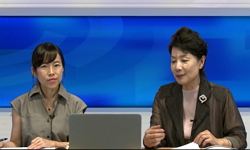본고에서는 유사한 경어체계를 가진 일・한 양 언어의 「경어의 오용표현」에 관하여 살펴보았다. 현대사회에서 사람과 사람의 커뮤니케이션을 원활하게 하고 확실한 인간관계를 구축...
http://chineseinput.net/에서 pinyin(병음)방식으로 중국어를 변환할 수 있습니다.
변환된 중국어를 복사하여 사용하시면 됩니다.
- 中文 을 입력하시려면 zhongwen을 입력하시고 space를누르시면됩니다.
- 北京 을 입력하시려면 beijing을 입력하시고 space를 누르시면 됩니다.
일·한 경어 사용실태 연구 : 오용표현 분석을 통하여 = (A) Study on the Honorific Usage in Japanese and Korean : Through Analysis of Misused Expressions
한글로보기https://www.riss.kr/link?id=T12379292
- 저자
-
발행사항
서울 : 명지대학교 교육대학원, 2011
-
학위논문사항
학위논문(석사) -- 명지대학교 교육대학원 , 교육학과 일본어교육전공 , 2011. 2
-
발행연도
2011
-
작성언어
한국어
- 주제어
-
DDC
401 판사항(21)
-
발행국(도시)
서울
-
기타서명
A Study on the Honorific Usage in Japanese and Korean : Through Analysis of Misused Expressions
-
형태사항
ⅴ,62 p. ; 26 cm.
-
일반주기명
명지대학교 논문은 저작권에 의해 보호받습니다.
지도교수 : 윤상실.
참고문헌 : p.59-60 - 소장기관
-
0
상세조회 -
0
다운로드
부가정보
국문 초록 (Abstract)
본고에서는 유사한 경어체계를 가진 일・한 양 언어의 「경어의 오용표현」에 관하여 살펴보았다. 현대사회에서 사람과 사람의 커뮤니케이션을 원활하게 하고 확실한 인간관계를 구축하는 중요한 요소인 경어는 언어가 끊임없이 변화되는 것처럼, 사회상의 변동과 함께 변화한다. 이처럼 경어가 변화하는 과정에서 경어의 과용이나 남용현상 또는 간소화현상 등이 나타나는데, 이러한 잘못된 경어의 오용표현으로 인해 언어 사용자들은 많은 혼란을 겪게 되며, 경어 오용의 기준이나 지침을 필요로 하게 된다. 본고에서는 일・한 양국의 드라마, 영화 시나리오, 방송자료, 오용 관련 문헌을 중심으로 경어의 오용표현을 각각 조사하였다. 또한 일본어의 경우 「敬語の指針」(2007)에 따라 5분류로, 한국어의 경우 민현식(1999)에 따라 3분류로 오용유형을 분류한 후, 경어의 정오(正誤)를 판별하기 위해서 경어 오용의 기준을 세우고, 일본어와 한국어 경어의 오용양상의 유사점과 상이점을 비교・분석하기 위한 방법의 모색을 시도하였다. 실제 시나리오, 방송자료, 오용에 관련된 서적을 중심으로 조사된 일본어 경어의 오용표현은 총 402회, 한국어 경어의 오용표현은 총 331회이다. 일본어 경어의 오용표현 총 402회 중에서 겸양어Ⅰ의 존경어화 현상 96회(23.9%), 부적절한 존경어의 대상의 존경어화 58회(14.4%), 과잉겸양 56회(13.9%) 순으로 나타났다. 이에 반해, 한국어 경어 오용표현 총 331회 중에서 「-시-」의 생략현상과 같은 간소화현상 99회(30%), 비격식체 상대 높임 84회(25.4%), 과잉경어(주체 높임법의 선어말 「-시-」의 중복 사용과 과잉존대) 68회(20.5%) 순으로 나타났다. 또한 일・한 양 언어의 유사점으로 2중경어・과잉겸양・부적절 대상의 존경어화·간소화 현상·자기 쪽 존경을 들 수 있다. 특히 복잡한 경어 체계 속에서 야기되는 존경어와 겸양어의 혼동 현상과 간소화 현상, 그리고 경도(敬度)를 높이기 위해서 나타나는 부적절한 대상 높임과 2중경어나 과잉경어, 상업경어와 같은 현상은 현대 사회의 특징을 반영하고 있다는 것을 알 수 있었다. 또한 일·한 양 언어의 상이점으로는 상하관계를 중시하는 특수한 높임법인 한국 경어의 압존법(壓尊法)의 오용, 일본어의 복잡한 경어체계에서 두드러지게 나타나는 겸양어의 오용, 일본어의 경어체계에만 존재하는 미화어의 오용을 들 수 있다. 일·한 양 언어의 경어 오용표현의 비교분석을 통해 변화 진행 중인 표현, 정착화·관용화 되어가는 표현과 점차 간소화 되어가는 표현 등 전반적인 구조적 특징과 흐름을 알아볼 수 있었다. 이상의 분석 결과를 토대로 경어의 중요성과 경어의 혼란을 바로잡을 수 있는 올바른 경어 체계에 대한 기준의 필요성을 인식하고, 보다 올바른 경어 표현 습득에 도움이 될 수 있으리라 기대된다.
다국어 초록 (Multilingual Abstract)
The misused expressions of Japanese honorific surveyed focusing on actual scenarios, broadcasting data, misuse related literature are 402 cases in total, and those of Korean is 331 cases intotal. Among total 402 cases of Japanese honorific misuse, the descending highest order was 96 times of honorified situation of honorific I(23.9%), 58 times(14.4%) of that to honorific subject, and 56 times(13.9%) of excessive diffidence. Whereas among total 331 times of misused expressions of Korean honorific, the descending highest order was 99 times(30%) of simplified situation like omission of 「-시-」, 84 times(25.4%) of unformal relative respect, 68times(20.5) of excessive honorific(overlapped use of pre-situated ending of subject honoring method 「-시-」and excessive treatment with respect. Also similarities of both Japanese and Korean can cite dual honorific, excessive humility, honorification of improper subject, simplified situation and honor of speaker. Especially, it could be noted that conditions like confusion and simplification situation and of an honorific and a humble speech caused in complicated honorific system, respect of a improper subject, dual honorific or excessive honorific, commercial honorific revealed to elevate respect extent incorporate the features of contemporary societies. Also differences of both Japanese and Korean can quote misuse of Korean honorific's overwhelming respect, a special honnorific method respecting hierarchy, misuse of an honnorific remarkably revealed at Japanese complex honorific system, and that of florid language existing only in Japanese honorific sytem. It could be noted that the comparative analysis of misused expressions in both Japanese and Korean honorifics witnesses the features and flow of general structures such as expression in change, that settled down and common, and gradually simplified. The above analysis is anticipated to realize the value of honorific and the need of standards for right honorific system to set right honorific confusion, and serve acquisition of right honoriffic expression.
This article examined into 「misused expression of an honorific」in both languages of Japanese and Korean having similar honorific system. An honorific vital to smooth inter-personal communications and build up a solid interpersonal relation in cont...
This article examined into 「misused expression of an honorific」in both languages of Japanese and Korean having similar honorific system. An honorific vital to smooth inter-personal communications and build up a solid interpersonal relation in contemporary societies changes along with social changes just as language continues changes on and on. Similarly, in the process of honorific change, the misuse, abuse or simplification conditions of an honorific come out, and such misused expression of wrong honorificmakes language users go through much confusion, and needs the standards or guidelines of honorific misuse. This paper explored the misused expressions of an honorific focusing on dramas, movie scenarios, broadcasting data, and misuse related literature in both Japan and Korea. Japanese was categorized to 5 misuse types by 「honorific's guidelines」(2007), and Korean was to 3 ones by Min Hyun Shik(1999), after that, criteria of honorific misuse were set up, and a method was sought to compare and analyze the similarities and differences of Japanese and Korean honorifics.
The misused expressions of Japanese honorific surveyed focusing on actual scenarios, broadcasting data, misuse related literature are 402 cases in total, and those of Korean is 331 cases intotal. Among total 402 cases of Japanese honorific misuse, the descending highest order was 96 times of honorified situation of honorific I(23.9%), 58 times(14.4%) of that to honorific subject, and 56 times(13.9%) of excessive diffidence. Whereas among total 331 times of misused expressions of Korean honorific, the descending highest order was 99 times(30%) of simplified situation like omission of 「-시-」, 84 times(25.4%) of unformal relative respect, 68times(20.5) of excessive honorific(overlapped use of pre-situated ending of subject honoring method 「-시-」and excessive treatment with respect. Also similarities of both Japanese and Korean can cite dual honorific, excessive humility, honorification of improper subject, simplified situation and honor of speaker. Especially, it could be noted that conditions like confusion and simplification situation and of an honorific and a humble speech caused in complicated honorific system, respect of a improper subject, dual honorific or excessive honorific, commercial honorific revealed to elevate respect extent incorporate the features of contemporary societies. Also differences of both Japanese and Korean can quote misuse of Korean honorific's overwhelming respect, a special honnorific method respecting hierarchy, misuse of an honnorific remarkably revealed at Japanese complex honorific system, and that of florid language existing only in Japanese honorific sytem. It could be noted that the comparative analysis of misused expressions in both Japanese and Korean honorifics witnesses the features and flow of general structures such as expression in change, that settled down and common, and gradually simplified. The above analysis is anticipated to realize the value of honorific and the need of standards for right honorific system to set right honorific confusion, and serve acquisition of right honoriffic expression.
목차 (Table of Contents)
- 제1장 서 론 1
- 1. 연구목적 1
- 2. 연구범위 및 방법 3
- 제2장 선행연구 고찰 6
- 1. 일본어 경어의 선행연구 6
- 제1장 서 론 1
- 1. 연구목적 1
- 2. 연구범위 및 방법 3
- 제2장 선행연구 고찰 6
- 1. 일본어 경어의 선행연구 6
- 1.1. 일본어 경어의 분류 6
- 1.2. 일본어 경어의 오용 9
- 2. 한국어 경어의 선행연구 10
- 2.1. 한국어 경어의 분류 10
- 2.2. 한국어 경어의 오용 11
- 제3장 일본어 경어 오용표현 분석 14
- 1. 존경어의 오용 14
- 1.1. 2중경어 16
- 1.2. 부적절한 대상의 존경어화 18
- 1.3. 간소화 현상 20
- 1.4. 자기 쪽 존경 20
- 2. 겸양어의 오용 22
- 2.1. 겸양어의 존경어화 24
- 2.2. 겸양어Ⅰ의 존경어화 25
- 2.3. 겸양어Ⅱ의 존경어화 26
- 2.4. 겸양어Ⅰ의 과잉경어 27
- 2.5. 겸양어Ⅰ의 미화어화 29
- 3. 공손어의 오용 30
- 3.1. 공손어의 존경어화 31
- 3.2. 유추 오류 31
- 4. 미화어의 오용 32
- 4.1. 접두사お,ご의 남용 32
- 제4장 한국어 경어 오용표현 분석 34
- 1. 주체 높임법의 오용 35
- 1.1. -시-의 생략 36
- 1.2. 과잉경어 38
- 1.2.1. 시의 중복사용 38
- 1.2.1. 과잉존대 39
- 1.3. 압존법의 오용 40
- 1.4. 부적절한 대상 높임 41
- 1.5. 자기 쪽 존경 42
- 2. 객체 높임법의 오용 44
- 2.1. 객체 높임의 쇠퇴 45
- 2.2. 과잉객체 높임 46
- 2.3. 객체 높임의 존경어화 47
- 3. 상대 높임법의 오용 47
- 3.1. 비격식체 상대 높임 48
- 제5장 일한 경어 오용표현 비교 50
- 1. 일한 경어 오용의 유사점 50
- 2. 일한 경어 오용의 상이점 53
- 제6장 결 론 56
- 참고문헌 59
- ABSTRACT 61











